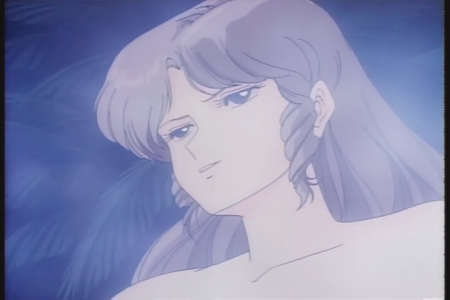Ask John: Is Project A-Ko the First Yuri Anime?
Question:
Would PROJECT A-KO be of anthropological significance for being one of, if not even the, first yuri anime? The entire film is, at its’ core, primarily about B-ko trying to impress C-ko, a girl she’s got an unhealthy fascination with so she’ll dump her “best friend” – the title character – and join her in her giant decadent Roman bath, obviously for reasons that have absolutely nothing to do with living out pent up sexual frustration from when they were in kinder garden. I know that Kaze to Ki no Uta was the first yaoi anime/yaoi manga, but don’t have a clue where the roots to girl-love date back to in Japanese pop culture. Your insights?
Answer:
The introduction of romantic affection between girls in Japanese literature is widely credited to author Nobuko Yoshiya 1916 series of “Class S” (Class Sister) stories about female classmates that develop intensely devoted relationships, Hana Monogatari (Flower Story). Yoshiya’s influence appears in contemporary “Class S” dramas including Maria-sama ga Miteru and Aoi Hana. The modern concept of yuri arose in manga in the early 1970s in works like Ryoko Yamagishi’s 1971 Shiroi Heya no Futari (Our White Room) and Riyoko Ikeda’s 1975 series Oniisama e (To My Elder Brother). The term “yuri,” used to identify lesbianism as a genre, arose in the mid 1970s when the common Japanese women’s name “Yuri” became a default anonymous name for lesbian women.
The “Class S” inspired intense devotion and idolization between female classmates appears in 70’s anime including Attack No. 1 (1969) and Ace wo Narae (1973), but since overt lesbianism didn’t establish itself in manga until the mid 1970s, there should be little surprise that it didn’t transition into anime until the early 1980s. As far as I know, Cream Lemon OVA 2: Escalation, released on September 10, 1984, is anime’s first true yuri anime. This Class S story depicted lesbian affection between girls in an all-girl Catholic school, culminating in consensual lesbian sex and lesbian rape. The Wonder Kids’ Lolita Anime IV: Hensokyoku released on December 20, 1984, also depicted graphic sex between women, but this sex was motivated by situational passion rather than lesbian inclination. Literal lesbianism appeared again in Cream Lemon OVA 4: Pop Chaser, released on March 13, 1985.
The presence of a yuri theme in Project A-ko shouldn’t be entirely surprising since the film was initially conceived as a Cream Lemon episode. To an extent, particularly B-ko’s suggestive bath scene may serve as a significant historical landmark denoting the transition of overt lesbianism from adult anime into mainstream anime, but Project A-ko seems much more historically significant for its inspiration of descendant girl action/overkill anime like Katsugeki Shoujo Tanteidan, Elf-17, Twinkle Heart, Cleopatra DC, and Ojousama Sousama.
Add a Comment
You must be logged in to post a comment.



I wouldn’t call an anime from “Cream Lemon” or “Wonder Kids” yuri. Their simply porn with lesbians because, well, apparently guys think girl on girl is hot. (I’m gay so I wouldn’t understand)
IMHO in Yuri sex isn’t the focus of the story, even if it’s in there, but instead the characters and their feelings/relationships. The best example of this might be the works by Ebine Yamaji.
But probably that’s just a matter of semantics (like the ongoing yaoi vs. BL discussion).